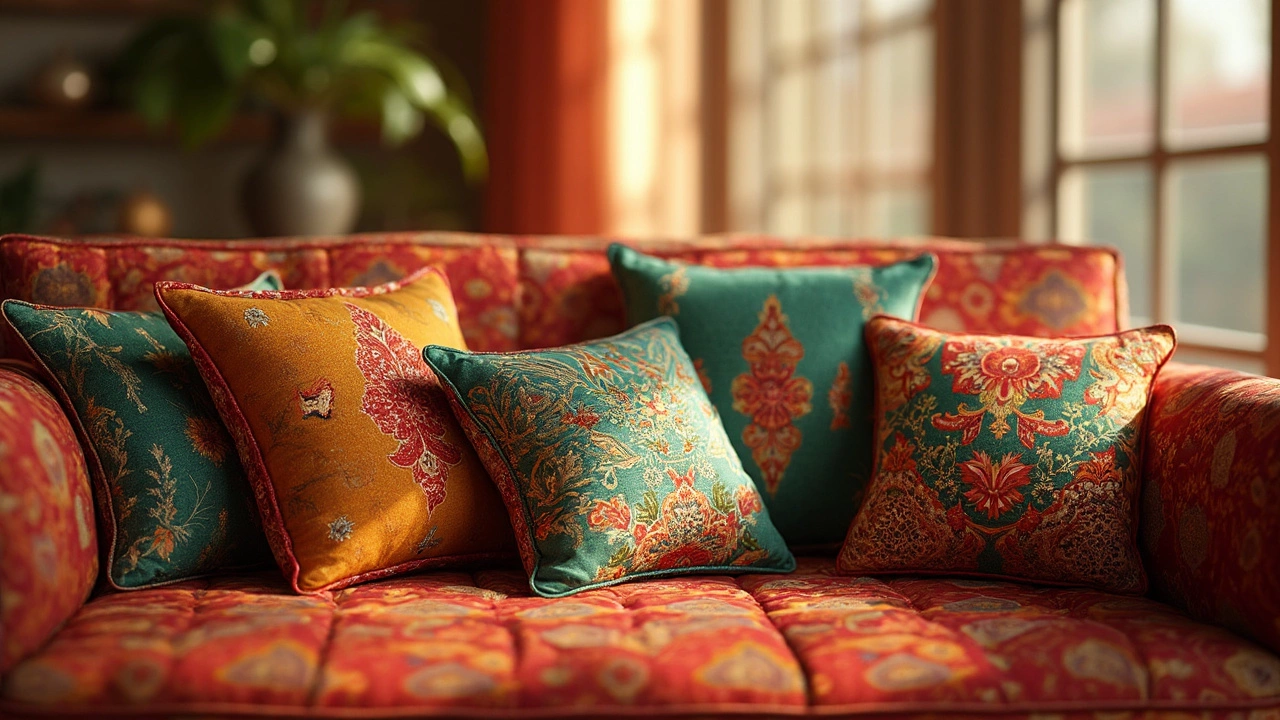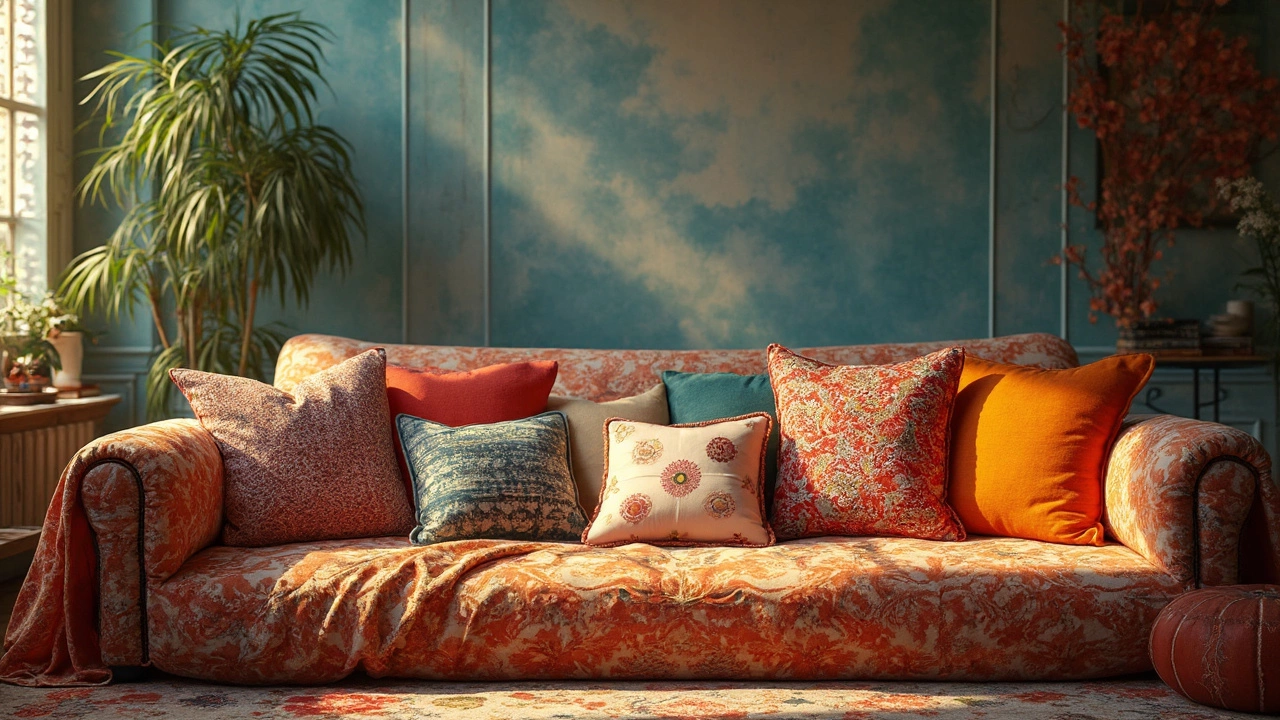How Many Cushions to Have on Your Couch?

Ever plonked down on someone’s couch and been engulfed by a sea of cushions? Too many turns your sofa into a pillow fortress; too few, and it looks like something’s missing. So how do you strike the perfect balance?
Generally, the rule of thumb is odd numbers. Odd numbers of cushions, like three or five, tend to create visual interest and symmetry. But don’t stress—there’s no hard and fast rule here. It’s more about what vibe you’re going for. A pair of cushions can give a clean, minimalist look, while more can lend a collected, cozy aura.
Think about the purpose of your couch too. If it’s for lounging during TV marathons, more cushions might mean more comfort. They can support your head or prop up a tablet. If it's for a formal sitting room, fewer cushions can enhance a tidy, pleasant atmosphere.
- The Basics of Cushion Arrangement
- Style and Aesthetic Considerations
- Function and Comfort
- When Less is More
- Exploring Color and Texture
The Basics of Cushion Arrangement
When it comes to arranging cushions on your couch, the goal is to create a comfy, inviting space while keeping an eye on style. First off, consider the size of your couch. A larger sofa can accommodate more cushions without looking cluttered, while a smaller couch might do better with fewer, bolder choices.
Cushions generally fall into three sizes: large, medium, and small. Start with the largest ones at either end of the couch for support and anchor them there. This creates a solid base. Then, layer in your medium cushions next, which should be comfortable enough for lounging but decorative too.
Creating Balance
For a balanced look, it's often recommended to keep cushions in odd numbers, like three or five. But don't let rules box you in—if your heart desires symmetry with an even number, go for it! Balance can also be achieved through the color and texture of your cushions. Mixing up textures like velvet, cotton, and woven fabrics can add depth without adding busy-ness.
- Start with a base layer of cushions in neutral tones.
- Add pods of color with smaller cushions or throws.
- Mix patterns with solids to break up any monotony.
Another interesting fact? Studies show that people often prefer tactile comfort on their couches, meaning textures play a big role in our cushion preferences. So, touch and test!
Function versus Fashion
Ask yourself: is this sofa more for show or for serious lounging? If it’s the latter, make sure your cushions are not only stylish but also soft enough for propping and napping. Lastly, keep in mind that positions can be adjusted! Moving your cushions around often can keep your couch looking fresh and trendy.
Style and Aesthetic Considerations
Your couch is like the centerpiece of your living room, so it needs to reflect your personal style while also setting the tone for the room's decor. Whether your home leans modern or vintage, the cushions you choose should seamlessly align with that vibe.
Mixing Patterns and Colors
Don't shy away from mixing and matching! If your couch is a solid color, consider adding patterned cushions to bring some visual interest. On the flip side, if your couch has a busy pattern, solid-colored pillows can balance it out.When it comes to colors, the 60-30-10 rule often works wonders. Here's the gist: Use three colors in your living room's design—60% dominant, 30% secondary, and 10% accent. Cushions are a perfect way to bring in that 10% of accent color.
Playing with Texture
Texture can be just as impactful as color. Mixing textures—like velvet with cotton or knits with silk—creates layers and depth. Not only does it make for an eye-catching arrangement, but it also invites guests to get cozy on your couch.| Texture | Pros | Considerations |
|---|---|---|
| Velvet | Luxury feel, rich colors | May be higher maintenance |
| Cotton | Durable, easy to clean | Can wrinkle easily |
| Knit | Cozy, homely vibes | Thicker, may heat up |
Proportion and Scale
Think about the size of your couch and the room. For smaller sofas, oversized or too many cushions can feel overwhelming. Larger sectionals can handle bigger, chunkier cushions. Keep it all in balance so everything feels proportionate and welcoming.Ultimately, your choice in cushion style and aesthetics should tell a bit of your story. They’re not just accessories—they're a peek into what makes you tick! Go bold, go neutral, play around, and remember, it's about having a comfy couch where you feel truly you.

Function and Comfort
When it comes to couch decor, you gotta think about comfort. After all, your couch is likely one of the main spots in your home where you unwind. Adding the right number of cushions can make a pretty big difference.
First off, consider the size of your couch. A larger couch might need more cushions to feel inviting, while a smaller sofa may get overwhelmed if you go overboard. The key is making sure those cushions are functional, not just pretty. They should help you in your everyday use, like offering lumbar support or being a soft place to land after a long day.
Mixing It Up for Comfort
Don't just stick with one size or shape. Mixing different cushion shapes—like square, rectangle, and even round—can cater to different comfort needs. Want to nap? A bigger cushion makes a nice headrest. Want lumbar support? Reach for a small rectangular cushion.
Layering for Support
If you often find yourself sinking into the couch with a favorite book or movie, layering cushions can add support. Start with a larger cushion at the back and stack a smaller one in front. This not only boosts comfort but also spices up the look with different textures and colors.
| Cushion Arrangement | Benefits |
|---|---|
| Layered Cushions | Provides varied support |
| Mixed Shapes | Offers both back and head support |
| Symmetrical Arrangement | Gives a balanced feel |
At the end of the day, personal preference wins. Test different arrangements until it feels right to you. Pay attention to how you naturally use the couch and adjust the cushions to match. Your living room should be a place of relaxation, not furniture frustration!
When Less is More
Sometimes, less is more, especially when it comes to cushions on your couch. You don't always need a tidal wave of pillows to make a strong stylistic statement. Here’s why going minimal can be a game changer for your couch decor.
Clutter-Free Living
Cutting down on cushions can immediately make a room feel more open and uncluttered. This is particularly beneficial in smaller living rooms where space is at a premium. A few well-chosen, well-placed cushions can provide comfort without creating a visual mess.
A Focus on Quality Over Quantity
With fewer cushions, you can invest in higher quality fabrics and designs. Think premium textiles or artisanal patterns that catch the eye but don’t overwhelm the space. Choose interior design pieces that feel good to touch and easy on the eyes.
The Illusion of Space
Believe it or not, too many cushions can visually weigh down your furniture. By opting for fewer cushions, you allow the beauty of your couch to shine through. This hint of minimalism can make the room feel larger and more sophisticated.
The Table of Simplicity
| Number of Cushions | Effect |
|---|---|
| 1-2 | Minimal, simple, chic |
| 3-4 | Balanced, cozy, warm |
| 5+ | Luxurious, layered, but can be overwhelming |
Ultimately, the number of cushions you choose hinges on your personal style and the functionality of the space. But next time you're poised to throw an avalanche of pillows on your couch, remember: sometimes one or two beautifully curated cushions are all you need to nail that living room aesthetic.

Exploring Color and Texture
Getting into the color and texture game can truly elevate your couch decor. It’s like art class for your living room, and you’re the artist. But instead of paints, you’re playing with cushions.
Choosing the Right Colors
When it comes to colors, there's a sweet spot between coordination and chaos. If your couch is a neutral tone, it’s the perfect canvas for bold cushion colors. Think eye-popping colors like mustard yellow or deep teal. But what if your couch already screams color? Then you might want to tone down the cushions, opting for gentle colors to balance things out.
According to a recent interior design survey, 60% of people prefer to match their cushions with other room accents like rugs or wall art. This can create a cohesive look that ties the room together.
Playing with Textures
Texture is the unsung hero of couch decor. Mixing textures can transform a boring couch into the heart of your living room. Combine velvet with linen or a chunky knit with smooth cotton to add layers and interest.
You might also want to have a couple of knitted or embroidered cushions. They add depth without overpowering the aesthetic vibe. Plus, textures can influence the room's feel—think cozy in the winter with faux fur or light and airy with breezy linens in the summer.
Patterns and Prints
If you’re feeling adventurous, mix patterns and prints with solid colors. Geometrics can offer a modern edge, florals bring a soft classic touch, while stripes are always a safe bet. Mixing patterns adds character and can reflect your personality. Just keep the color palette consistent to avoid clashing.
- Start with a base color that complements the couch.
- Add a second color for contrast.
- Finish with a pattern that includes both colors.
By thoughtfully exploring the colors and textures of your couch cushions, you’re not just dressing up a piece of furniture. You’re crafting an inviting atmosphere that tells a story about your style.